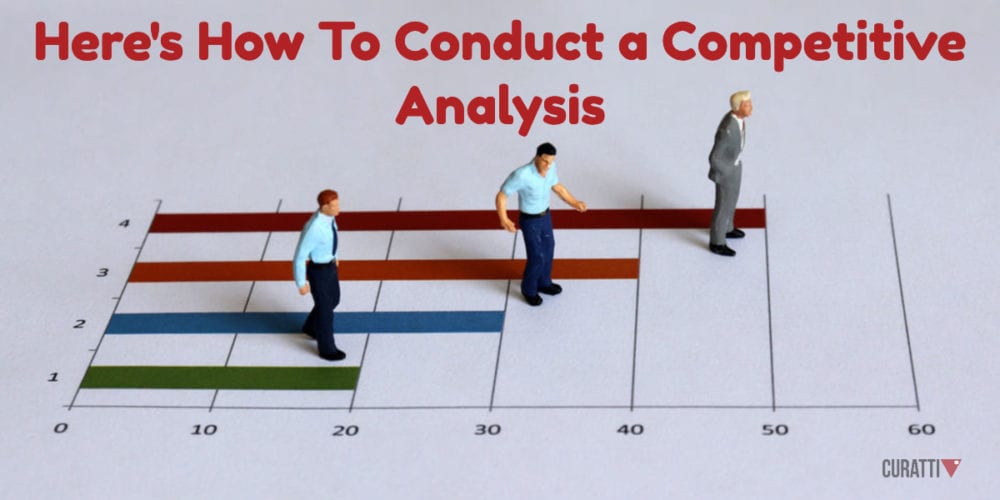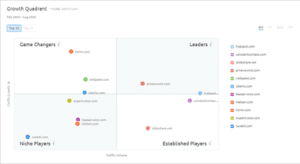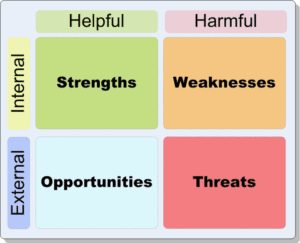How To Conduct A Competitive Analysis In Marketing

Competition is a game-changer but it can also kill success if you don’t know how to use it to your advantage. No matter what size your business is, you’ll be going head-to-head with the competition and in order to come out on top, you need to know how they make their bank account light up.
If you’re new to competitive analysis or need a refresher course and have questions, this information will help you level up and get a competitive advantage. Read on for proven methods to topple the competition and rise to the top.
What Is Competitive Analysis?
As a business owner, you’re likely focused on your products and services while targeting how to market these items to the masses through a fool-proof marketing strategy. Unfortunately, this tunnel vision focused on your company alone, and only your product or service can get you blindsided when competitors forge ahead.
With competitive analysis, you take the necessary time and methods to monitor the competition. This isn’t a one-time deal. You continually track the progress of your competition and analyze what they’re doing to sell products and make money. Doing so will help you to up your game, sell more, and be a better business overall.
This process is a multi-layered one with many different methods to accomplish your analysis goals, so you’ll likely have questions along the way. It also shows you how you should be pursuing your sales goals.
Now that you understand what competitive analysis is and why you need it, the next step is to identify the competition so you can create the best marketing strategy.
Who Are Your Competitors?
There are two main types of competitors to be mindful of, indirect competitors and direct competitors. Both are your competition, so you have to know how to identify them, analyze their marketing techniques, and make sure you are the best of the bunch.
Indirect Competitor
Indirect competitors are those who target the same keywords and audience you do. However, their monetization methods differ.
For example, affiliate marketers are indirect competitors for eCommerce brands. They are using the same keywords and promoting the same products as you, but aren’t directly selling the product or service. Affiliate marketers can be your competitors but also excellent partners if you join forces with them by having them market your products in their content.
Direct Competitor
Direct competitors are businesses selling the same product or service within the same niche as you. These are companies and individuals that you’re battling for the attention of the buyer. The same keywords, audience, and monetization strategy are being pursued by both you and your direct competitors.

You want to understand how these direct competitors are marketing their product or service and monitor their progress along the way. By doing so, you’ll know what it takes to lead the pack. You should focus mainly on direct competitors, however, don’t completely check indirect competitors off your list of potential competition. These indirect competitors may turn into direct competitors at some point in the future, so be sure to keep your eye on them, too. But, for now, focus your marketing analysis on direct competitors alone.
How Do You Conduct Competitive Analysis in Business?
Competitive analysis takes many forms. You can choose one method that works for you or increase the odds of your success by using a few options.
Here are some proven ways to conduct competitive analysis:
List Your Competitors
The first step is to list your competitors. You want to organize your competition in a who, what, and how questions format. First, determine who your target audience is overall. Then, identify what problem your product helps to solve. Lastly, note how your product solves this problem. SEMrush’s market explorer tool is a good resource for quickly identifying competitors.
Then, take all this information and determine what other companies are similar to yours, i.e., who your direct competitors are. The same goes for figuring out who your indirect competitors are in the market and zoning in on these individuals, too.
Research The Company Overview Sections
To do a competitive marketing analysis the right way, you want your list of competitors to include other companies that have similar attributes. It’s a good idea to look at competitors and note their founding date, business model, number of employees, revenue, number of customers, and other important details. It’s also important to know about their funding capabilities and any potential investors they might have. At the end of each company overview, list a few of the company’s identified strengths and weaknesses.
Customer Acquisition Analysis
Once you have a good idea as to the building blocks of the company, the next step is to look at how they get their customers and answer questions accordingly. Here are a few areas to focus on for the customer acquisition analysis section:
- Target customer base: The target customer base of your competitors gives you insight on who they sell their products to and how they tailor their products to these customers.
- Strategic messaging: Strategic messaging enables the company to focus on their target customers and entice them with the right type of messages in their marketing strategy. How do these companies target customers with strategic messaging and is this messaging successful?
- Marketing content: Look at how the company promotes its marketing plan content. How do they get the word out on their products and specials? Does the company use social media, website content, influencers, and more with their content marketing? Do they use one main method or multiple methods to get the word out?
- Products and pricing: Review the product types and pricing on these products or services as offered by your competitors. Consider the prices of all products as well as any discounts the company might offer. What’s their market share compared with your market share and do they focus on industry trends?
- Sales channel: How does your competitor sell their products and do they have multiple sales channels or specialize in one main mode of selling? Which sales channels are successful and which ones leave much to be desired for lack of sales?
- Customer acquisition strategy: How do the competing companies draw target customers in and make them buy their products? You should note if the companies have one main way to turn target customers into buying customers or use multiple methods for doing so.
Online Presence Of Your Competition
Companies that have a fool-proof, unforgettable online presence will be fierce. A solid online presence keeps these competitors at the forefront of the minds of their customers, including past, current, and future.
When looking into the online presence of other similar companies to yours, note the following things:
- Do a quick review of their website to see if the competition is a tech-savvy entity or one that’s not up-to-date with the latest and greatest technology.
- Check out your competitor’s keyword performance with competitor analysis tools such as SEMrush to see the top keywords competitors are using in the product niche and are ranking high in the search engines.
- Click on the various web pages to see if the content on each page is high in word count or sparse in number.
- Review the website for contact information, such as a phone number, and see how they communicate with their customers. Is it difficult for customers to contact the company representatives with questions or extremely easy to have questions answered with various contact methods available?
- Visit their social media platforms for digital marketing insight. How are these companies using their social media to effectively market their products and are you doing the same? What platforms are doing the best, i.e., Facebook, Twitter, Instagram? You can find out a lot simply by looking at their number of followers and the content that is posted on each platform. Also see if they use one main social media platform or put the full spectrum of social media options into motion.
- Does their website contain blog posts, press releases, F.A.Q.s section, or other informative content?
- Do they offer customer loyalty programs?
Competitive Analysis Review
When you review the content and marketing materials in this competitive landscape, dig further in to see what the actual content of your competitor looks like, not just if it exists. Explore the content during your competitor analysis to see if the information is really that informative and if it’s accurate. Some companies may put boring and unrelated content on their website to fill up pages. But that might miss the mark when it comes to being insightful and effective.
Also, be sure to note the presentation of the content and see if the grammar and spelling are on point and it’s written with persuasion. How it’s written is equally as important as what is written. If the content is nothing but empty words, and misspelled words at that, the effectiveness won’t be there and the content won’t be doing the job it’s meant to do. You can be the better choice by putting out information that is relevant and worth the read. Ultimately, good, informative content amounts to far better marketing of your company and products or services.
You should also see how the content is received by customers and potential customers. Does it receive good feedback and thoughtful comments or is it filled with negative responses from readers? Is there a phone number for the customer to call to provide feedback, good and bad? It’s not just important to have good content, but it should be well received by the reader.
SWOT Analysis: Start With The Competitor Strengths
Now that you have good insight into the competitor companies and how they operate in an online setting, you want to perform a SWOT analysis on the competitor, which includes strengths and weaknesses. The SWOT analysis uncovers the strengths of the competitors, weaknesses of the competitors, opportunities for your company, and threats to your company.

Looking at the strengths and weaknesses is extremely important in your competitor analysis. The strengths and weaknesses identify what your competition is doing right and wrong.
Start with the strengths of competing companies. What sets them apart from the rest and makes them shine amongst the competition? Consider how they compare with your company with regard to:
- Company size
- Location
- Target audience
- Offerings
- Focused value proposition
- Delivery time
- Market share
- Price point
- Quality standards
If these competing companies rival yours in any or all of these areas, mark it down in your data and be mindful of these strengths going forward with your comparisons.
You may also want to read: The 9 Elements In a Successful Business Marketing Plan
Competitor’s Weaknesses Must Be Noted
It’s not just what makes other companies better than others, it’s what makes them less so, too. Figure out what some of the weaknesses of your competitor might be. These competitor weaknesses might be readily apparent or take a little digging to uncover. Some company aspects that might signify weakness include:
- Low profit margin
- Low gross margin
- Ineffective sales team
- Less than ideal website and technology components
- Poor customer service
- Slow delivery
- Poor quality products
These weaknesses will bump these companies down a few notches on your comparison data and bring your company closer to the top.
Identify Opportunities For Your Company
Now that you know the portion of the SWOT analysis that focuses on your competitor, figure out what your opportunities might be. As the information starts filling up on your competitor analysis charts, you want to compare what you offer and what the competition offers. That’s the bottom line. Once you have a clear picture, you can look for gaps in the market and figure out what potential opportunities your company has to market your current products or new products down the road. How can you use marketing strategies to get the results you want quickly and efficiently?
By knowing what others offer in the way of products or services and what might still be desired yet not addressed in your product niche, this is your time to strike. You can tackle the market and offer the products that are in demand by your target customers and not being offered by the competition. Your company can jump in the lead by focusing on these new opportunities and offer the best product or service.
Identify Threats To Your Company
There are also potential threats to your company that could hinder your marketing goals with your products or services. Identify things to be wary of when marketing your products or services and be sure to avoid falling into those traps. What works for your competitors that might not work for you? Or, what things failed to work for the competition that you should steer clear of? Doing a competitive analysis doesn’t just tell you what you should do, but what you shouldn’t do as well.
Look for the warning signs and make sure to market your products or services in an entirely different way or market entirely different products. Strengths and weaknesses on both sides should be exposed.
You may also want to read: How To Create An Efficient Marketing Plan
Understanding The Competition Helps You Conquer It
Once you understand how your competition operates and the successes and failures they’ve encountered along the way, your company can grow and flourish. There’s a lot to be learned from the competition, especially in the area of marketing a product or service.
And know that competitive analysis with regard to marketing isn’t an event to be accomplished one time only. You want to perform periodic analyses of your competitors as the market is continually changing and so are the products or services. When one company might fade away, another one is waiting to take its place. And this latter one might just be bigger, better, and more of a threat to your company as competition.
Once you have competitive intelligence, you can take the proper measures to market your product effectively to potential customers and face your competitor. A competitor analysis will do all this and more.
 Darren has 15+ years of marketing experience for retail, manufacturing, and internet corporations. Darren has an MBA in Internet Marketing and is the Co-Founder of Ecommerce CEO. You can connect with him on LinkedIn here, on Facebook here, or follow/tweet him @darrendematas
Darren has 15+ years of marketing experience for retail, manufacturing, and internet corporations. Darren has an MBA in Internet Marketing and is the Co-Founder of Ecommerce CEO. You can connect with him on LinkedIn here, on Facebook here, or follow/tweet him @darrendematas
Sign Up For Our Mailing List
If you’d like to receive more in-depth articles, videos, and Infographics in your inbox, please sign up below

Sign up for the newest articles from Curatti, delivered straight to your inbox
Featured image: Copyright: ‘https://www.123rf.com/profile_kanghj103‘ / 123RF Stock Photo
